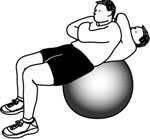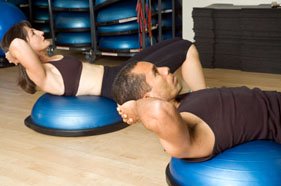The Ultimate Exercise Ball Guide
If you are like most people, locating the right exercise ball to enhance your workout plans to burn fat or build muscle can be tough. There is the fitness ball, the BOSU ball, and the medicine ball. Which one should you use and when?
I want to clear up some of that confusion here.
If you have walked into a gym lately (and I know you have!), you have no doubt seen the many exercise classes going on throughout the day. More and more, these classes are employing an exercise ball of some type to increase the intensity and variety of the workouts.
Because of the many types of balls out there, I can understand how it might be confusing and intimidating. Trust me, though, it is worth the effort to learn more and incorporate some of these tools into your workout programs. So let's get started.
Using a ball for exercise has many benefits, including increased balance and coordination, core strength and muscle control.
However, there are many types of balls to use in your workouts, and they all have different purposes.
Exercise ball exercises often include movements to target the core, like crunches. They also include routines to enhance weight training either on the ball, in the case of physio ball exercises, or while holding the ball for resistance in the case of medicine ball exercises.
Fitness Ball (aka Swiss Ball, Stability Ball)
A fitness ball is arguably the most popular type of exercise ball, though you will often hear it called a Swiss ball. This is because it was first widely used in Switzerland for physical therapy.
This workout tool is also often referred to as a physio ball, yoga or Pilates ball, balance ball, or therapy ball. If you ever hear any of these names, you can feel sure that people are talking about this particular workout ball.
They are constructed of soft PVC and range from the small, measuring 35 centimeters (14 inches) in diameter, to the very large, which measure 85 centimeters (34 inches) around.
 |
Physio ball exercises are mostly used to activate and strengthen hard to reach core muscles; however, they can be used to enhance your weight training plans as well.
They are used for building muscle, strength, stability, burning fat, rehabilitation, improving balance and enhancing flexibility.
Stability Ball Exercises for Your Workout Plans
These balls have been used as a yoga ball or as a Pilates ball.
Others have used a stability ball to replace their normal sitting chairs for watching television or sitting at their desk, opting instead for an exercise ball chair.
Because you can find a ball in several sizes, it is important to find the right size for your Swiss ball training plan.
To find the right size, make sure that when sitting on the ball your legs form a 90 degree angle, and that the ball is not to big (creating more than 90 degree angle) or to small (creating and angle less than 90 degrees).
BOSU Ball: Half Ball, Half Amazing
BOSU is an acronym for "BOth Sides Up."
 |
©iStockphoto.com/leezsnow |
A BOSU ball is a ball and plank combination. It looks like a yoga ball that has been cut in half and fixed to a board.
It can be used for step classes with the ball side facing up and the plank placed on the ground. This keeps the ball stable and allows you to focus on balance improvement.
When turned over such that the ball portion is on the floor, it is great for targeting unused muscle groups that help one balance and support the movement.
For example, when doing push-ups with your hands on the plank side, your stabilizer muscles in the chest are activated. Push-ups with your feet on the ball ads focus to your core muscles in your abdominal area and lower back. However, be careful, it takes some getting used to.
The BOSU ball can also be used to increase the intensity of sit-ups through providing a wider range of motion.
Medicine Ball: Just What the Doctor Ordered
The medicine ball has been around for a long time. These hollow, synthetic rubber balls are designed to be extremely durable and ranges in weight from 2 to 25 pounds.
They tend to work best with a partner or wall-related exercises and help to tone up the muscles in lieu of free weights.
 |
As opposed to the fitness and BOSU balls discussed above, where you are performing and exercise while on the ball itself, you use the medicine ball to provide resistance.
The can be used to increase explosiveness since they can be easily thrown to a partner or into the air. Also, because they are compact, they are excellent for adding resistance to your core exercises such as crunches or twists.
Medicine Ball Exercises to Build Muscle and Burn Fat
Medicine ball exercises are also great additions to any sport specific workout plans you are using to enhance you game. They can enhance swing power (baseball, golf, tennis), explosive vertical power (basketball), or lateral power (football, basketball).
Find the Right Exercise Ball for the Workout You Are Doing!
There are many choices of workout balls to enhance your next trip to the gym. You have the BOSU to add variety and new challenges to your muscle building and fat burning workout plans.
You also have medicine balls to add resistance for those who want to have a "toss."
Finally, fitness balls as the exercise ball of choice for a variety Swiss ball exercises.
The key is choosing the right ball for the right exercise to maximize the results of your build muscle and burn fat workout programs.
Leave the Ultimate Exercise Ball Guide and Return Home




